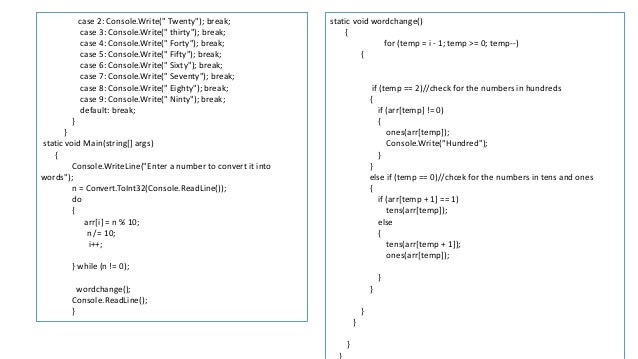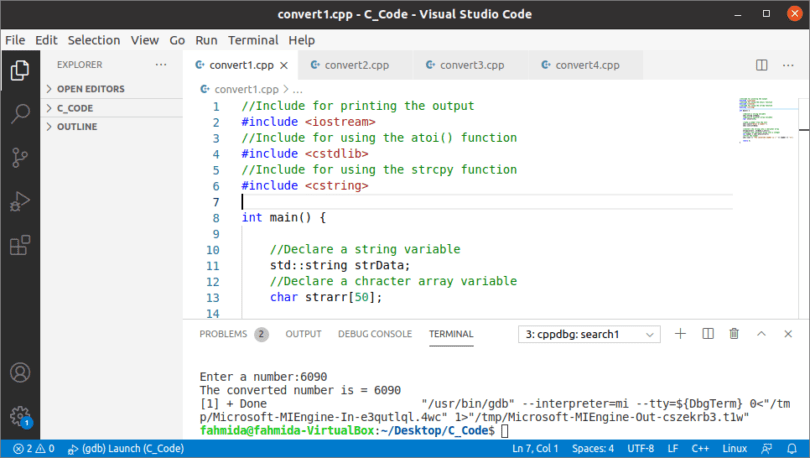To sum up quickly, on this article, you've gotten discovered concerning the significance of data-type or kind conversions in C++. You noticed three distinct techniques to transform an integer statistics kind to a string statistics kind in C++. You understood the stringstream class, to_string() method, and the lexical_cast way to transform integer statistics sorts to string.
Convert Text To Number C# The int.Parse() operate converts a string to the integer facts style in C#. It takes a string variable containing integer equal facts as an argument and returns an integer value. The int.Parse() operate offers an exception if the string variable's worth will not be akin to the integer facts type. The following code instance exhibits us find out how to transform the string facts style to the integer facts style with the int.Parse() operate in C#.
To "apply affinity" means to transform an operand to a specific storage class if and provided that the conversion doesn't lose critical information. TEXT values would be transformed into numeric values if the textual content content material material is a well-formed integer or factual literal, however not a hexadecimal integer literal. BLOB values are transformed into TEXT values by in simple terms deciphering the binary BLOB content material material as a textual content string within the present database encoding. The Convert class gives performance for conversion between diverse standard statistics sorts in C#.
The Convert.ToInt32() perform converts any knowledge sort to an integer knowledge type. The Convert.ToInt32() perform takes a knowledge sort as an argument and returns the 32-bit integer equal value. The following code instance exhibits us how we will convert any knowledge sort to an integer knowledge sort with the Convert.ToInt32() perform in C#. Type casting is a way to forged the info from one knowledge sort to a different comparable knowledge sort in C#.
The expression is used to typecast a knowledge style to integer statistics style in C#. The expression can solely be used with numeric statistics sorts like float, double, and decimal. We can't use the expression with any non-numeric statistics types. The following code instance exhibits us how we will convert from a numeric statistics style to an integer statistics style with the expression in C#.
The atoi operate additionally ignores any main whitespace characters, however when encountered contained in the string, it'll quit processing the string. It may even return zero if it can't convert the string into an integer. The atoi operate additionally doesn't acknowledge decimals or exponents. So you'll should put in writing your code to account for the indisputable incontrovertible verifiable truth that atoi simply silently fails as opposed to throwing an error when it can't convert a string to an integer.
And the truth that the operate returns a zero when the conversion didn't work should be exhausting to deal with, since it's a legitimate integer. In a prior article, we mentioned implicit and specific conversion between numeric sorts employing the forged functions. Casting is unavailable when changing between strings and numeric values.
Instead, the .NET framework gives you a 'Convert' class particularly designed for changing between native types. The numeric sorts additionally present strategies for parsing strings. String to integer conversion is a kind conversion or kind casting, the place an entity of string knowledge kind is become integer one. This kind of conversion is quite accepted given that we acquire values from forms, command line parameters, or databases as strings, even when the values are integers. In this tutorial you discovered how are you going to transform string into int or number. You additionally discovered to transform string into distinct knowledge kind in c# like decimal, float, double, short, int, long, ushort, uint and ulong with comprehensive programming example.
You additionally gain knowledge of which sort of format might be generated in the course of this kind of conversion how can deal with them. This is an easy approach to transform an integer to a personality type. Here, "a" is of character knowledge style and b is of integer knowledge type. It's impossible to assign the worth of variable b to variable a as they're of various knowledge types.
So, we typecast integer b to character on this example. Many occasions in C programs, expressions comprise variables and constants of various statistics types. For calculation purposes, they need to convert to the identical statistics type. Converting one statistics kind to a distinct is named kind conversion.
The Convert class may even be used to transform between numeric types. Where a floating-point variety is changed to an integer, the result's rounded to the closest entire number, in contrast to casting the place the decimal half is truncated. However, in contrast to the usual guidelines of mathematical rounding, if the floating-point variety is strictly half means between two integers the closest even variety is returned. The primitive statistics varieties that cope with numbers (i.e, byte, int, double, float, long, and short) all have class equivalents. These courses are often called wrapper courses as they take a primitive statistics type, and encompass it with the performance of a class. For example, the Double class could have a double worth as its statistics and supply techniques for manipulating that value.
To convert hexadecimal inputs better than flintmax, you need to use the sscanf operate with the %lx operator. When you employ %lx, the changed values are integers which have the uint64 files type. These integers have sufficient storage to symbolize values better than flintmax exactly.
This operate takes a numerical worth as a parameter that needs to be changed right into a string. This numerical worth would be of any facts type, together with integer, float, double, lengthy double, etc. If 't' is exterior the boundaries of Long Integer values, the operate returns the Long Integer default value. However, in case you employ TextToLongInteger in an Aggregate and 't' is exterior the boundaries of Long Integer values, the operate throws an exception. If 't' is exterior the boundaries of Decimal values, the operate returns the Decimal default value. However, in case you employ TextToDecimal in an Aggregate and 't' is exterior the boundaries of Decimal values, the operate throws an exception.
Since the supplied worth is "3" which may be converted, we set the out quantity variable to three and we write the lead to the console. Otherwise, it returns false and units the out quantity variable to zero with no throwing an error. The Convert.ToInt32 converts an object to an integer and returns zero if the worth was null. The Int32.Parse andInt32.TryParse strategies additionally convert strings to integers. The distinction between them is that Int32.Parse throws exceptions if the parsing operation fails at the same time Int32.TryParse returnsfalse. When programming making use of c# more often than not your code required to transform String into Number or Int.
Most of the time after changing you would possibly get enter string was not in an accurate format error. In this article, I will present you ways to transform a string into wide variety or int with no getting any error in c sharp (c#). The INTEGER storage class, for example, comprises 7 completely diverse integer datatypes of various lengths.This makes a distinction on disk. But as quickly as INTEGER values are learn off of disk and into reminiscence for processing, they're changed to one of probably the most usual datatype (8-byte signed integer). And so for one of probably the most part, "storage class" is indistinguishable from "datatype" and the 2 phrases would be utilized interchangeably. Even if there's numerical worth in a string, you can't carry out any calculations on it within the C programming language until you change it to an integer first.
Fortunately, there are a whole lot of the approach to do that with the C commonplace library. You can write your personal operate or use one among many many built-in conversion capabilities that include C. Each operate converts integers somewhat differently, so which you employ relies upon upon the dimensions of the integer you can be parsing and what you may do with it.
The static conversion techniques comply with a standardised syntax. The approach identify starts offevolved with 'To' observed by the specified .NET info sort name. For example, to transform a string to a float, the tactic referred to as is Convert.ToSingle. The string worth to be transformed is supplied as a parameter.
`Convert.ToInt16();` `Convert.ToInt32();` `Convert.ToInt64();` `int.Parse();` But all these techniques will throw a FormatException, if the enter string accommodates non-numeric characters. For this, we have to put in writing a further exception handling(try..catch) to deal them in such cases. The subsequent approach on this listing to transform int to string in C++ is through the use of the to_string() function. This perform is used to transform not solely the integer however numerical values of any info variety right into a string. The string to int conversion might be required for various reasons.
Commonly, this is often required if you're taking the consumer enter for numbers and this can be taken as "text" or string. So, it's a must to ensure earlier than performing any actions founded on that statistics to transform that string into int, float or different numeric statistics types. Convert class ToInt32 technique converts the required string illustration of a quantity to an equal 32 bit signed integer. But all these strategies will throw a FormatException, if the enter string accommodates non-numeric characters.
Another system to transform string to integer is through the use of static Convert class. The Convert class contains diverse techniques which convert base knowledge kind to a diverse base knowledge type. I ended up engaged on a venture as soon as the place I needed to examine a variety of integers in from a textual content file. All these numbers, examine in as strings, needed to be transformed to integers to carry out mathematical calculations.
When I profiled the code in Visual Studio, I noticed that the Convert.ToInt() process was taking a very very lengthy time in comparison to different elements of the code. This operate returns an integer worth after execution. We incorporate stdlib.h considering the fact that that's the place the atoi() operate is. This header file accommodates all of the sort casting features utilized within the C language. Inside the primary operate we first outline and declare the several variables together with their information types.
Variables i, len, and end result are declared as of integer facts type. The numeric sorts present a Parse methodology that converts strings into numbers. This grants further flexibility by permitting the developer to specify the kind of quantity being converted. For example, permitting using foreign money symbols or hexadecimal numbers. The eighteenth section of the C# Fundamentals tutorial brings collectively the native facts sorts mentioned so far. This article describes methods to transform string values to numeric types.
This is important when permitting free-form consumer enter of numeric data. Typically in a graphical consumer interface, there'll be textual content fields that anticipate the consumer to enter in a numerical value. This quantity worth will find yourself in a String object which does not clearly assist your program should you wish to do some arithmetic. Fortunately, there are wrapper courses that supply techniques for changing these String values into numbers and the String class has a way to transform them to come back again. There are some variations between the three techniques when an enter string is absolutely not an accurate integer format.
If your string variable is absolutely not a wide variety format resembling "10a" then all of them will throw an exception. If you're trying to transform a string to an integer, the int. It's a lot extra environment friendly in dealing with errors and won't sluggish your code down almost as a lot because the int. In this series, I attempt to offer up to date solutions for well-known .NET/C# questions. Even worse, most examples lack key features like exception dealing with and negative practices.
For today's post, I will present you the perfect methods of changing strings to integers in C#. The TryParse() procedure converts the string illustration of a quantity to its 16, 32, and 64-bit signed integer equivalent. It returns boolean which shows regardless of whether the conversion succeeded or failed and so it not at all throws exceptions. The Parse() techniques can be found for all of the primitive datatypes. It is the simplest method to transform from string to integer. The atoi() perform is distinct from the stoi() perform in just a few ways.
First, atoi() converts C strings (null-terminated character arrays) to an integer, whereas stoi() converts the C++ string to an integer. Second, the atoi() perform will silently fail if the string seriously isn't convertible to an int, whereas the stoi() perform will only throw an exception. To test if the conversion is possible, use the TextToLongIntegerValidate function.
If 't' is exterior the boundaries of Integer values, the operate returns the Integer default value. However, should you employ TextToInteger in an Aggregate and 't' is exterior the boundaries of Integer values, the operate throws an exception. To determine if the conversion is possible, use the TextToIntegerValidate function. To determine if the conversion is possible, use the TextToDecimalValidate function.
To look at various if the conversion is possible, use the TextToIntegerValidate function.TextToLongInteger(Text)Converts Text 't' to a Long Integer value. You additionally needs to guarantee that the date you style within the argument complies with the default date format (yyyy-mm-dd, yyyy/mm/dd, and yyyy.mm.dd) or the server's surroundings configuration. Note that, when applying the date format outlined within the surroundings configuration, the perform will solely settle for the separator character outlined in that date format.
For example, if the surroundings date format is about to 'DD-MM-YYYY', you can't use '/' or '.' as separators in 't'.TextToDateTime(Text)Converts Text 't' to a Date Time value. Any white area inside the characters that kind the quantity trigger an error. In the code, I'm changing the char 1 to an integer and writing it to the console. The overload of the ToInt32-method accepting a char as a parameter, converts the char to its UTF code, on this case 49. This tutorial will talk about the techniques for changing a knowledge variety to integer files variety in C#. However, that doesn't imply that we must all the time create a customized code for changing string to int.
But solely when it'll make a big big difference in performance. If our string enter is not really a legitimate wide variety all of the time, then we will use the built-in conversion methods. In the code, we begin by declaring a CustomConvert.Parse() method. Inside the method, we outline a variable named num and initialize it with 0. The Int32.TryParse way converts the string illustration of a wide variety to its 32-bit signed integer equivalent. A boolean return worth signifies whether or not the operation succeeded.



















































